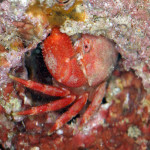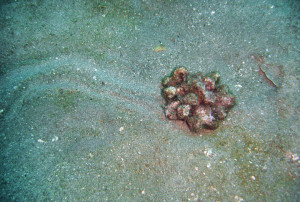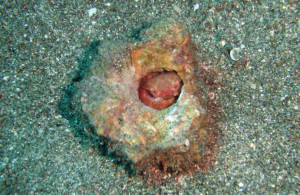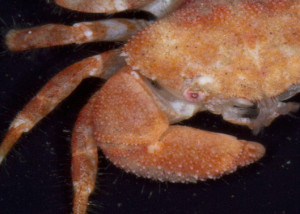
In Greek mythology, Atlas was the Titan
condemned by Zeus to hold up the celestial sphere.

Trail made by an Atlas crab (Actumnus obesus) moving its coral home.
Have you seen a kind of scruffy drag mark on top of the sand, only to find what looks like a rock or piece of coral rubble at the end of it? I’d seen these for years and every time I turned one over all I saw was a perfectly circular hole in the rock that dog-legged out of sight, making whatever was in there difficult to see. I assumed it was a kind of crab, but it wasn’t until a few months ago that I collected some of these coral pieces to observe in a holding tank.
The little crab that inhabits this coral rubble isn’t in popular Hawaii ID books, so it took the help of several people in the islands and on the mainland to match this crab with its name. It turns out to be Actumnus obesus Dana 1852, and – even though it is found throughout the Indian and West-Pacific Oceans – it was first collected and described from Maui! In 1852!
It always surprises me that people found things like this without SCUBA so many years ago. During the United States Exploring Expedition of 1838-1842, ship naturalists onboard the Albatross dredged these crabs “south of Molokai and near Lahaina.” It makes sense that these crabs were collected during the Maui part of that worldwide expedition as they are very common at diving depths along Maui’s leeward shore. The relatively protected leeward coastline of Maui and the fine sand allow the crabs to easily crawl around in search of food without getting thrown around by surf.

A coral nodule turned over to see the Atlas crab in its hole.
When Actumnus obesus was described, it was noted to have a deep, convex body (thus, the species name obesus, meaning fat) and short, stout claws. But since the dredgers did not see the crab in its natural environment, there was no description of how it used those adaptations. It wasn’t until over 100 years later that Melbourne Ward reported that another species of Actumnus excavated a burrow in a dead coral piece and then moved the coral from place to place.
Since then, two other species of Actumnus have been reported to exhibit similar behavior (some of them using pieces of coral that are still alive) (Johnson et. al., 2008), and now we’ve learned that Actumnus obesus is the fourth Actumnus species known to do so.
With the crabs in their little holding tank and me looking up at them while lying comfortably on my back beneath it, I was able to spend hours watching and videoing the crabs move about. Each crab would emerge from its hole, position its legs and claws and then abruptly thrust its claws and next two pairs of legs at the bottom of the tank propelling its coral piece rearward (while holding the coral with the last two pairs of legs). It was such a surprise! I had expected them to drag the piece of dead coral (like a hermit crab drags its shell), not pop it up off the bottom in spurts. Now the deep body and the large claws make sense – they are used to heft their home around!
You can see what I saw here: http://www.youtube.com/watch?feature=player_detailpage&v=OblcmLs2jsQ
To understand this feat a little better, I weighed one of the crabs and one of the average-size coral pieces. With the crab (wet) at less than a gram and the coral (dry) at 76.5 grams, the crab is lifting more than 150 times its own weight. That equates to a 150 pound person lifting 11 tons!

The granular surface of the claws is used to rasp a hole in the coral nodule.
Their deep body houses the muscles necessary for the large claws to do the heavy lifting. That makes sense. Now, how do they make that hole in the coral?
You can see that the carapace and the claws are covered with tiny pointed granules like the teeth on a rasp. Using their claws (and possibly their carapace) they excavate the perfect size hole in their coral home, and are presumably able to enlarge the hole as they grow.
The extreme ease with which they slip into and out of their hole is another example of nature’s perfection. Who knows how many more adaptations they have for their life within and underneath their coral homes?
In addition to watching their means of coral transport, I was also fortunate to see a female emerge from her rock and aerate her eggs, a male crab scraping material off of the rubble and eating it, and a pair of crabs perform a courtship ritual and get into their mating position. It was a warm and dry front-row seat to their precious world underneath their coral homes. I will post more descriptions and videos of their private lives soon.
Thanks to Cory Pittman and John Hoover for help with identification research and to Peter Castro for examining the photos and identifying this crab as Actumnus obesus Dana 1852. It is figured in Edmondson, C.H. (1962) Xanthidae of Hawaii. Occasional Papers of Bernice P. Bishop Museum, 22(13), 215-309 [p. 290, figs. 27a, 28a].
Johnson, Peter R., Davie, Peter J. F., Neil, David T. and Fellegara, Ida (2008) Excavation, habitation and transportation of massive corals by the crab Actumnus setifer (Crustacea: Brachyura: Pilumnidae) in Moreton Bay, Queensland. Memoirs of the Queensland Museum – Nature, 54 1: 261-271.
Ward, M. 1942. A new genus and eight new species of Brachyura from Mauritius and the Chagos Archipelago. Mauritius Institute Bulletin 2: 39-48.
